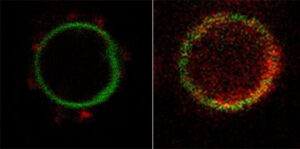
Catalytic nanomotors, which are nanostructures capable of collecting chemical energy from the environment and using it to move, are demonstrating great potential for biomedical applications. These nanomotors, or self-propulsed nanoparticles, are capable of “switching on” and starting to move in a fluid, using various biomolecules as fuel. This propulsion mechanism allows nanomotors to diffuse in larger volumes compared to their passive counterparts and thus easily reach a specific target, penetrate the tissues and perform better drug management.
The enzymes, organic molecules that accelerate the speed of a biochemical reaction, are ideal candidates for acting as catalytic energy sources for these nanomotors intended for the field of nanobiomedicine, as they are very diverse, substrate specific and, above all, they are present throughout the human body. However, in living organisms, these enzyme-driven nanostructures can be exposed to adverse conditions, such as strong pH variations, which could compromise both their movement and their chemical functionalities.
Now, a team of researchers from the Smart Nano-Bio-Devices group at IBEC, led by ICREA Professor Samuel Sánchez, and from the Supramolecular Nanochemistry and Materials group from ICN2, led by ICREA Professor Daniel Maspoch, have developed self-propulsed nanomotors that retain their functionalities after being exposed to different acidic pHs due to enzymatic encapsulation. IBEC and ICN2 researchers have demonstrated, as described in a recent article published in Advanced Functional Materials, the validity of this approach with a new type of nanomotors, called LipoBots (LBs), driven by the enzyme urease.
The authors of this study developed functional nanostructures in which the enzymes that provide fuel for movement—urease molecules in this case—are encapsulated in a liposome, i.e. a spherical vesicle that has a lipid surface of at least two layers (LipoBots-Inside, LB-I). In order to compare, they also synthesized another type of nanomotor, in which the urease enzymes are attached to the outer surface of the liposome (LipoBots-Outside, LB-O).
Researchers noted that while the LB-O diffuse autonomously in the environment due to urease on the outside of vesicles, the LB-I do not exhibit self-propulsion properties. However, this functionality can be recovered by introducing sodium deoxycholate, a component of the bile salts, into the environment where the LB-I are expected to move.
Researchers studied the consequences of exposure to adverse environmental conditions by incubating the two types of nanomotors in an acid medium of pH 3 and 5 (possible pH values in the human stomach) for 1 hour. This test revealed that both the ability of self-propulsion and the enzymatic activity of the LipoBots that have urease on the surface were completely lost. In contrast, the LB-I protected the encapsulated urease from the effects of the acid environment, so the nanomotors maintained their enzymatic activity. In addition, their active movement could still be activated by sodium deoxycholate.
This research opens the way for the application of encapsulated LipoBots to the development of new active drug administration systems. Since their enzymatic features are preserved after exposure to a hostile environment and their movement is activated in situ, these liposomes-based nanomotors could be used, for example, in the gastrointestinal tract, where bile salts are present naturally in the intestine.
Reference article:
Ana C. Hortelão, Sonia García‐Jimeno, Mary Cano‐Sarabia, Tania Patiño, Daniel Maspoch, and Samuel Sánchez, LipoBots: Using Liposomal Vesicles as Protective Shell of Urease‐Based Nanomotors, Adv. Funct. Mat., August 2020.





